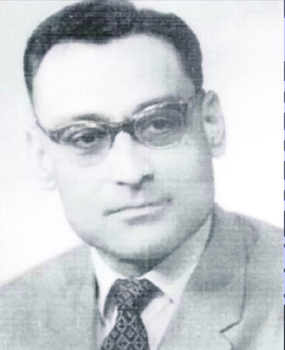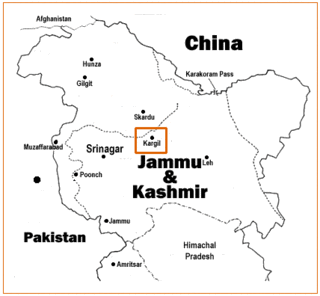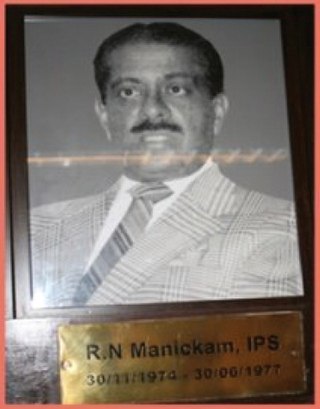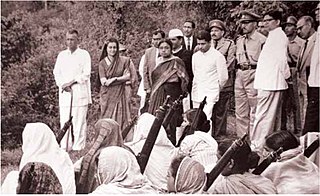The Research and Analysis Wing is the foreign intelligence agency of India. The agency's primary function is gathering foreign intelligence, counter-terrorism, counter-proliferation, advising Indian policymakers, and advancing India's foreign strategic interests. It is also involved in the security of India's nuclear programme.

The National Security Advisor is the senior official on the National Security Council of India, and the chief advisor to the Prime Minister of India on national security policy and international affairs. In 2019, the term of Ajit Doval the current NSA was extended for another 5-year term, and has been assigned the rank of a Union Cabinet Minister and ranks at the seventh position in the Indian Order of Precedence.

The Special Frontier Force (SFF) is an Indian special operations unit created on 14 November 1962. It mainly comprised Tibetan refugees living in India. Now it has increased in size and scope of operations. Its primary goal originally was to conduct covert operations behind Chinese lines in the event of another Sino-Indian War.

Rameshwar Nath Kao was an Indian spymaster and the first chief of India's external intelligence agency, the Research and Analysis Wing (R&AW) from its founding in 1968 to 1977. Kao was one of India's foremost intelligence officers, and helped build R&AW.

The National Technical Research Organisation (NTRO) is a technical intelligence agency of India. It was set up in 2004. The agency reports to the National Security Advisor and to the Prime Minister's Office. NTRO also comprises the National Critical Information Infrastructure Protection Centre and the National Institute of Cryptology Research and Development.
The Electronics and Technical Services (ETS) is the Electronic Intelligence (ELINT) arm of India's external intelligence agency Research and Analysis Wing (R&AW).
Below is a list of speculated CIA activities in India.

Sashastra Seema Bal is a border guarding force of India deployed along its borders with Nepal and Bhutan. It is one of the seven Central Armed Police Forces under the administrative control of the Ministry of Home Affairs (MHA).
Ayni Air Force Base, also known as Gissar Air Base, is a military air base in Tajikistan, 10 km (6.2 mi) west of the capital Dushanbe. The base is jointly operated by the Indian Air Force and the Tajik Air Force. It is India's second overseas air base after Farkhor. Since 2014 India has deployed Su-30MKI in limited numbers at this base. The base was extensively used by Indian Air Force as a standby base for its aircraft to evacuate Indian Nationals from Kabul Airport amidst the Afghan Crisis.
Krishan Chander Verma was the Director of Research and Analysis Wing (R&AW), the external intelligence agency of India, his official designation was Secretary (R). He did his schooling from Mayo College, Ajmer. He belongs to the 1971 Jharkhand IPS cadre. He started his career at the Intelligence Bureau, was appointed as head of the Narcotics Control Bureau in 2005, and was later elevated to the position of Secretary (Security) and also served as Internal Security Adviser to Home Minister. He was laterally transferred to head R&AW after Ashok Chaturvedi retired from the post on 31 January 2009. One of the major challenges for K. C. Verma had been professionalise and streamline the agency, which has been in news in recent times for various scandals and controversies.
Sanjeev Tripathi is member of the BJP and former Secretary of the Research and Analysis Wing. Tripathi is the son-in-law of Former R&AW secretary, G.S. Bajpai, and comes from a family of Bareilly, Uttar Pradesh. A keen sportsman, he topped the civil service exam in 1972, and joined the Uttar Pradesh cadre. Few years later, he switched to RAW, resigning from the IPS, and was absorbed in the Research & Analysis Service (RAS), which feeds the ranks of RAW. Mr. Tripathi is the first Secretary (R) to be from the RAS cadre in its more than four-decade history.
NETRA is a software network developed by India's Centre for Artificial Intelligence and Robotics (CAIR), a Defence Research and Development Organisation (DRDO) laboratory, and is used by the Intelligence Bureau, India's domestic intelligence agency, and the Research and Analysis Wing (R&AW), the country's external intelligence agency to intercept and analyse internet traffic using pre-defined filters. The program was tested at smaller scales by various national security agencies, and is reported to be deployed nationwide as of 2022.

Vikram Sood is the former head of India's foreign intelligence agency, the Research and Analysis Wing (R&AW), and an advisor to the Observer Research Foundation, an independent public policy think tank in New Delhi. Sood was an officer of the Indian Postal Service (IPoS) before he joined the intelligence organisation R&AW and later served as its spymaster from 2000 to 2003. He retired as a career intelligence officer with 31 years of service on 31 March 2003.

Madan Mohan Lal Hooja was an Indian Imperial Police officer who became Director General of Security and Director of the Intelligence Bureau.
The Centre for Air Power Studies (CAPS) is a think tank analysing issues related to national security, defence, and aerospace issues in the evolving strategic and international security environment. It was established as a research think tank on 15 September 2001, under an independent, non-profit, non-governmental trust registered in New Delhi titled "Forum for National Security Studies", officially registered under the existing regulations in New Delhi U/S 12 A of the IT Act in April 2002 and took over responsibilities for governing as the Centre for Air Power Studies (CAPS).
Anil Dhasmana is former Chief of National Technical Research Organisation (NTRO). He was also the Chief of the Research and Analysis Wing (R&AW), India's foreign intelligence service. He was appointed as the Chief of R&AW as the post fell vacant on 31 January 2017 following the retirement of the incumbent.

The Kargil Review Committee (KRC) was set up by the Government of India on 29 July 1999, three days after the end of the Kargil War. The committee was set up "to examine the sequence of events and make recommendations for the future".

Rishiyur Nataraja Manickam was an Indian Police Service officer in the Intelligence Bureau and the Research and Analysis Wing, and retired as Principal Director in R&AW's co-agency, Directorate General of Security. He was Director of the Aviation Research Centre during the Bangladesh War.

The Directorate General of Security is an organisation of covert operations under India's Cabinet Secretariat. It is one of the four legally defined intelligence organisations of India and listed in the Schedule of the Intelligence Organisations Act, 1985, the other three being I.B., R&AW and NTRO. Since 1971, the Secretary, Research and Analysis Wing has usually held the post of Director General. This organisation used to be composed of Special Service Bureau, Aviation Research Centre, Special Frontier Force and Chief Inspectorate of Armaments. Since the shifting of SSB and CIOA to the Ministry of Home Affairs in 2001, DGS consists of ARC and SFF only. The Special Group, a non-Tibetan and Sarsawa-based unit of SFF, is also a DGS component.












